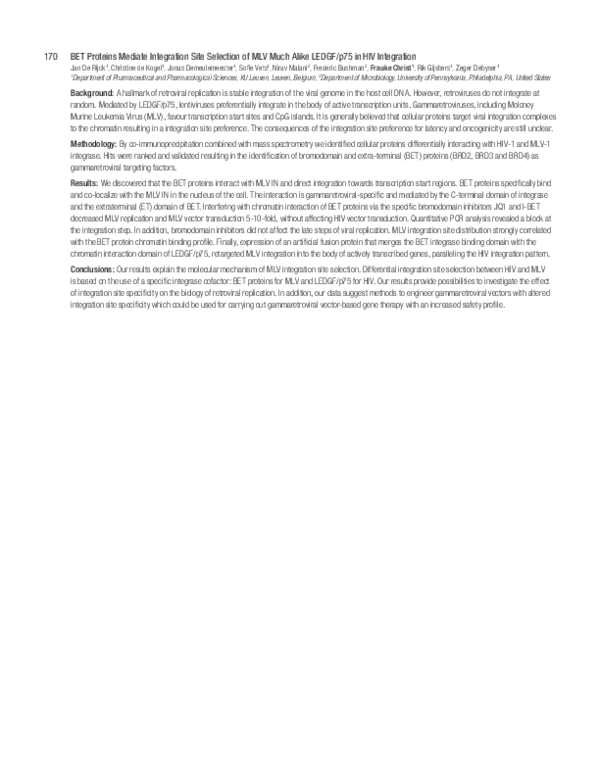Academia.edu no longer supports Internet Explorer.
To browse Academia.edu and the wider internet faster and more securely, please take a few seconds to upgrade your browser.
BET proteins mediate integration site selection of MLV much alike LEDGF/p75 in HIV integration
BET proteins mediate integration site selection of MLV much alike LEDGF/p75 in HIV integration
Related Papers
Journal of Virology
Bromo- and Extraterminal Domain Chromatin Regulators Serve as Cofactors for Murine Leukemia Virus IntegrationHuman immunodeficiency virus (HIV-1) requires integration of the viral genome into the host DNA for replication. Efficient HIV-1 integration employs a host co-factor LEDGF/p75 to stabilize the HIV-1 integration complex and tether that complex to host chromatin. Integration may be studied with purified components HIV-1 integrase (IN), LEDGF/p75, and DNA mimicking the ends of the viral DNA genome (vDNA) assembled as an intasome. There is a likely order of addition during infection with HIV-1 IN binding to vDNA before encountering LEDGF/p75. However, the ordered assembly of wild type HIV-1 IN, LEDGF/p75, and oligomer vDNA has not been tested. Variable assemblies occurred on ice before the addition of target DNA. Incubation on ice and addition of LEDGF/p75 were required to assemble complexes capable of efficient concerted integration. Integration efficiency following variable order of addition of intasome components was greatest when LEDGF/p75 was added last to preassembled HIV-1 IN and...
2006 •
Molecular Therapy - Methods & Clinical Development
Shifting Retroviral Vector Integrations Away from Transcriptional Start Sites via DNA-Binding Protein Domain Insertion into Integrase2018 •
Nucleic Acids Research
Modulation of the intrinsic chromatin binding property of HIV-1 integrase by LEDGF/p752021 •
The stable insertion of the retroviral genome into the host chromosomes requires the association between integration complexes and cellular chromatin via the interaction between retroviral integrase and the nucleosomal target DNA. This final association may involve the chromatin-binding properties of both the retroviral integrase and its cellular cofactor LEDGF/p75. To investigate this and better understand the LEDGF/p75-mediated chromatin tethering of HIV-1 integrase, we used a combination of biochemical and chromosome-binding assays. Our study revealed that retroviral integrase has an intrinsic ability to bind and recognize specific chromatin regions in metaphase even in the absence of its cofactor. Furthermore, this integrase chromatin-binding property was modulated by the interaction with its cofactor LEDGF/p75, which redirected the enzyme to alternative chromosome regions. We also better determined the chromatin features recognized by each partner alone or within the functional...
Genes & Development
LEDGF/p75 functions downstream from preintegration complex formation to effect gene-specific HIV-1 integration2007 •
2010 •
Background During the early stage of HIV-1 replication, integrase (IN) plays important roles at several steps, including reverse transcription, viral DNA nuclear import, targeting viral DNA to host chromatin and integration. Previous studies have demonstrated that HIV-1 IN interacts with a cellular Lens epithelium-derived growth factor (LEDGF/p75) and that this viral/cellular interaction plays an important role for tethering HIV-1 preintegration complexes (PICs) to transcriptionally active units of host chromatin. Meanwhile, other studies have revealed that the efficient knockdown and/or knockout of LEDGF/p75 could not abolish HIV infection, suggesting a LEDGF/p75-independent action of IN for viral DNA chromatin targeting and integration, even though the underlying mechanism(s) is not fully understood. Results In this study, we performed site-directed mutagenic analysis at the C-terminal region of the IN catalytic core domain responsible for IN/chromatin binding and IN/LEDGF/p75 int...
Proceedings of The National Academy of Sciences
Lens epithelium-derived growth factor fusion proteins redirect HIV1 DNA integration2010 •
RELATED PAPERS
Biostratinomy and Paleoecology of a Cretaceous Brackish Lagoon
Fursich Kirkland 1986 Paleoecology Cretaceous Brackish Lagoon Dakota Fm Black Mesa Arizona1986 •
The Mainstream Weekly
Ahmad Salim -a Punjabi poet who became a pul (bridge) between three Punjabs | Pritam Singh with Nuzhat Abbas2024 •
CPCL European Journal of Creative Practices in Cities and Landscapes - Vol 6 n. 1 - MEDITERRANEAN IMAGINARIES
Atlas of Mediterranean Liquidity: Immerse - A Submerged Map to Reveal Hidden Connections Between Water and Anthropic Life in Genoa Photo by Corpi Idrici and Zones Portuaires Genova2024 •
Ministerio Apostolico y Profetico Cristo Rey
El Dios de Abraham el Dios de Isaac y el Dios de Jacob2018 •
Studia Politologiczne
Poselski immunitet formalny w dyskusjach parlamentarnych (na przykładzie Druku nr 433/VI kad.)2021 •
2023 •
Science & Society
Cuba's Socialism: Certainties and Crossroads2024 •
Health Services Insights
Health in Crisis: A Paradox of Access for Syrian Refugees and Lebanese Hosts2024 •
La Mujer Guna Dule de Ipkikuntiwala
La Mujer Guna Dule de Ipkikuntiwala - Portada Revista la Mucura 92020 •
1996 •
Walailak Journal of Science and Technology
A Survey on Algorithms Based on Bee Swarms for Ad Hoc Networks2014 •
Andes pediatrica
La rehabilitación respiratoria infantil a la luz de la investigación cualitativa: Aquello que los números no pueden mostrar2023 •
arXiv (Cornell University)
Right-sided multifractal spectra indicate small-worldness in networks2017 •

 Christine De Kogel
Christine De Kogel